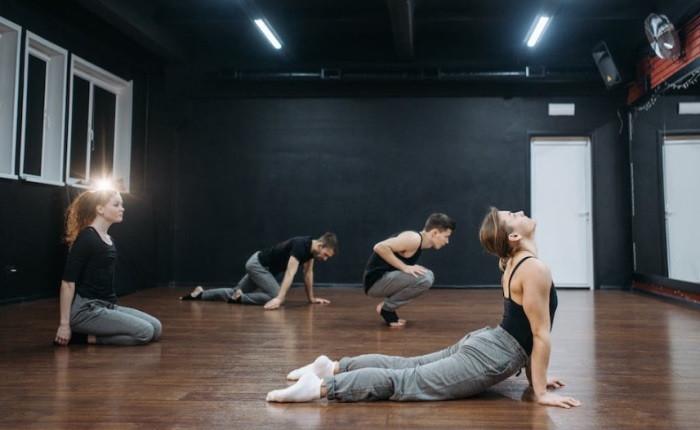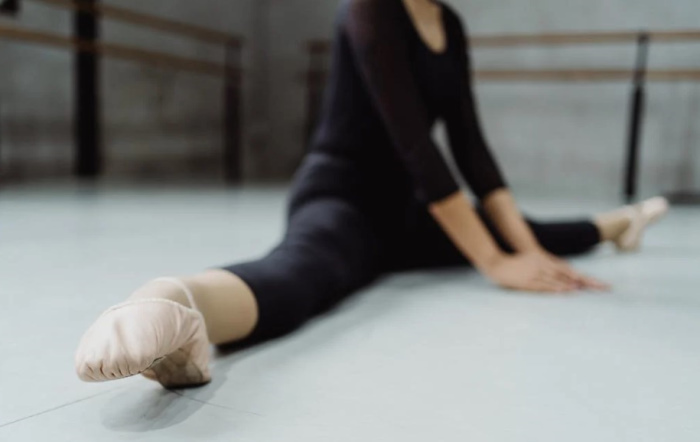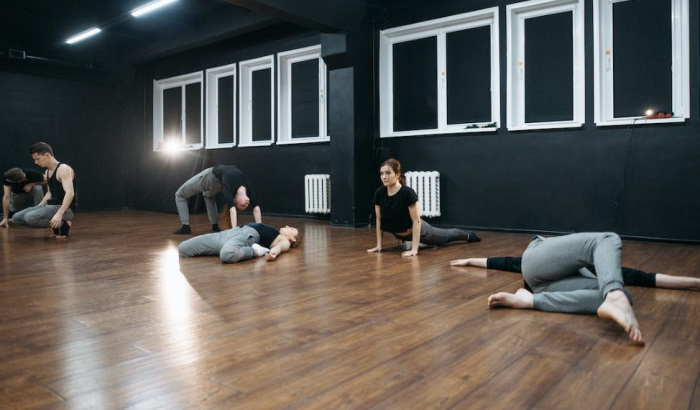Warm-up and cool-down are 2 inevitable parts of every dance performance. Why is a warm-up for dancers important? And how to do warm-ups effectively?
Let’s this article to learn more about dance warm-ups and pick up the best exercises for your warm-up routine.
Table of Contents
Why Is It Important To Warm Up Before Dancing?
It increases the body temperature gradually
Warm-ups act as physical and mental preparation. They let your body ready for high-intensity activities like dancing, workouts, and running. In terms of physical practice, warm-ups by mimicking the movement patterns in dancing let our body temperature increase gradually.
When our joints have time for warm-ups, there will be more synovial fluid lubrication to make our movements smoother. Our nerves, muscles, and joints are activated.
Some related effects of doing warm-ups before a performance are better body coordination, better dancing techniques, and higher psychological focus.
It reduces the risk of injury
Doing warm-ups appropriately also reduces the risk of injury to our bodies.
The temperature of our body and muscle increase gradually, thanks to the blood circulation boost. Since there is less anaerobic energy (energy without oxygen) in our heart and lungs, we will have less chance of experiencing tiredness, stiffness, and heaviness.
It boosts the flexibility
Doing warm-ups before a dance performance, class, or rehearsal helps improve the quality of the performance itself.
By boosting the elasticity of our muscles via leaps, jumps, and stamps, our body will have a full range of motion. Thus, you will be more flexible and represent the work at its best quality.
Check more: 7 Best Knee Pads For Dancers To Avoid Injuries
What Should A Warm-Up For Dancers Include?
Generally speaking, there is no ideal or best warm-up for dancers. A warm-up for dancers should include some factors. First and foremost, it should be related to your dance activity. For example, jazz moves should start with a jazz warm-up, or a ballet dance should begin with a ballet warm-up.
Besides, some other factors affect your warm-ups, such as your fitness level, your other activities in the day, the weather (temperature), and also your time and space.
At the end of the warm-up session, and by the time you are ready for the stage:
- Your body should feel warm with an elevated heart rate. Yet, you can still breathe normally and maintain a normal conversation.
- Be sweating (a must!).
- Your muscles and joints should also feel warm.
- Make easy moves in a full range of motion and with high precision.
An Effective Warm-Up Routine
- An effective warm-up should take at least 20 minutes: You should never shorten your warm-up timing since your joints and nerves can lack time for lubrication before the performance.
- Involve the controlled, large, general movement of your large muscle groups in a warm-up: This could be walking around the stage or moving in multiple directions. If you are having to take care of your old injuries, you should ask for advice from doctors.
- Warm up all parts of your body that will be involved in the performance: For example, if the performance involves the movements of your arms, hand joints, wrists, elbows, and shoulders, you should warm all these joints altogether. Plus, if your upper body supports weight, you should include it in your warm-up exercises with some gentle lifts.
- Gradually increase the intensity, pace, and range of motion of your movements, thus increasing your body’s temperature. Try to involve all your large muscles in this preparation, including your feet, knees, hips, and ankles.
Some possible methods are arm swings and circles, turning your knees higher, lunges, easing your hip joints around from front to back/left to right, rolling your spine, or moving your neck around.
- Your mind should also be ready for the stage: To do a mental warm-up, you should get closer to the pace you will use during the dance activity, or be more specific to your dance style.
- Add some cardio warm-up for dancers like small, simple jumps when your body temperature starts to rise. Make quick changes in multiple directions, quick stops, and keep your body balanced on one leg to engage proprioceptors.
- Sharing is caring! You should do some partnering sequences to help your partner warm up his/her brain and body. Start from simple, easy versions of quick, precise movements and increase the difficulty gradually.
Some Basic Dance Warm-Up Exercises
Jumping jacks
Jumping jacks consist of small movements. This exercise is among the ideal dance warm-ups for beginners. They help elevate your blood flow and heart rate and get your large muscle groups ready for static stretching.
Do 2 sets of 20 jumping jacks as a kickoff for your warm-up routine.
Leg swings
Apart from full-body warm-ups like jumping jacks, you can do some isolation warm-up exercises like leg swings. These exercises allow your legs to be more flexible and move in a full range of motion.
- To do a leg swing, stand with one leg forward and the other leg lifted.
- Bend one leg slightly from the front to the back of the room.
- Repeat at least 10 times for each leg.
Use a ballet barre or a chair to stay balanced.
Lunges
Lunges are great warm-ups for your lower body, like the glutes or quads.
- To perform a lunge, stand upright so that the width between your feet equals to your the width between your shoulders.
- Slide a foot backward so that your other foot’s knee is bent above your front foot while your back leg stays straight.
- Keep your body lower and lower to make the stretch as deep as possible.
- You can place your palms on the floor to stay balanced if needed.
Repeat this action 10 times on the other leg with the same depth.
Heel raises
Raising your heels before a dance performance allows your hamstring and calf to stretch and be more flexible.
- To make a heel raise, stand upright with your feet facing forward.
- Then, stand on your toes, raise your heels off the ground, then come back to the first standing position.
Repeat at least 10 times.
Hip swings
Warming up your hip joints is a must to make smooth movements in a real performance.
You can lubricate your hip joints by standing upright so that your feet are shoulder-width apart. Then, swing your hips clockwise and repeat at least 10 times counterclockwise.
Neck turns
Some neck isolation exercises (for example, the neck turns) can be acted as a short start before your rehearsal.
- Stand upright with your hands on your hips, then slowly look to the right then left, and vice versa.
- Plus, you can stretch your neck joints better by rolling your neck clockwise and counterclockwise.
Shoulder rolls
Similar to neck turns or hip swings, rolling your shoulders helps stretch the muscles and tendons in your shoulder. Thus, you will have less chance to suffer from back and neck injuries while dancing.
- You can make simple shoulder rolls by standing upright and your head facing forward.
- Lift your shoulders max to the ceiling, then low to the ground.
- Repeat this process 10 times or more to make your shoulders stretch to their fullest.
Breathing exercises
Simple warm-up exercises like deep breathing not only enhance your lung capacity and your blood circulation but also improve the overall performance of your muscles. You can do deep breathing exercises alone, or between and during muscle stretches.
Inhale slowly to allow as much oxygen to go deeply into your lungs as possible. Then, exhale to relax your muscles and dilate your blood vessels.
Choreography
You can do a gentle choreography after dynamic movements and static stretches. This exercise keeps all muscles activated and ameliorates the effectiveness of your warm-up.
Check more: 10 Famous Dance Photographers
Some Warm-Ups For Specific Types Of Dance
Warm up for jazz dancers
A warm-up routine for jazz dancers should start with stretching exercises. Then continue with isolation exercises for specific muscle groups. Some warm-ups for jazz can be:
- Muscle lengthening by stretching the hamstring and thigh.
- Small, continuous movements with light jogging.
- Joint easing to maximize the range of motion for hip joints, ankle joints, shoulder joints, and spine. Some typical exercises can be hip circles, ankle circles, arm circles, extensions, and spinal flexion.
- Oblique criss-cross or stand on one leg to improve your balance and strength
Warm up for ballroom dancers
You should do some basic warm-ups alone or with your dance partner to lubricate your body muscles for the performance. Some warm-up exercises for ballroom dancers are:
- Leg exercises: forward bend, walking/static lunges, walking/standing knee to chest, calf stretch, quad stretch.
- Neck/back/shoulder exercises: neck stretch, shoulder rolls, shoulder activation on the wall or stretch with partners, chest opener with a partner, back bend with a partner, and side body stretch.
Warm-up for ballet dancers
A warm-up for ballet dancers consists of 2 phases – a dynamic warm-up and a static stretching.
- Dynamic warm-up
A dynamic warm-up maintains a stable blood flow through your muscles. Thus, loosening and warming them up to reduce the risk of injuries.
This first step in warm-up for ballet dancers also prepares ligaments and joints, as well as gradually raises your heart rate. Some workouts here are shoulder rolls, jogging in one place, and leg swings.
- Static stretching
After finishing the dynamic warm-up and right before the performance, you should do static stretches to protect your muscles from injuries and pains.
As a ballet dancer, you can keep your body still to stretch your muscles and hold the stretch for a few seconds per time.
The stretching step with some exercises like leg stretches, toe touches or split stretches helps loosen and lengthen the muscles, hence enhancing overall flexibility.
Some Notice During A Warm-up
How long should a dance warm-up be?
An effective warm-up should take a minimum of 20 minutes. And no more than 5 minutes for the dynamic warm-up.
The length and type of warm-up are varied by dancers. For example, some dancers need a long warm-up to get well-prepared for the performance.
Also, you should also consider shortening or lengthening the warm-up based on your level of fitness. Ensure that the warmup elevates your heart rate without letting you out of breath.
Dance warm-up clothes
To make the warm-up effective and comfortable, choose clothes that are designed for fitness activities. These clothes should be made of breathable fabrics, can stretch a lot, and absorb sweat well.
Dancing shoes are also an inevitable part of dance warm-up clothes. Shoes for warm-up should allow you to move in a full range of motion. They shouldn’t be too old, broken, or lose their traction. Since your body will be warmed during this session and can make a lot of sweat, the shoes should be made of breathable fabrics.
A rule of thumb for dancers – always remember to check your shoes to make sure that they are in good condition before starting the warm-up.
Avoid injuries
There are some important notices to make a safe warm-up without injuries:
- Identify which muscles or muscle groups you will need most during the performance based on basic anatomy. Then, you will pick up the best stretch positions for yourself.
- Ask your physiotherapist to check the joints around those muscles. Are there any joints that have restricted movements? You should also do warm-up stretches in proper alignment to avoid injuries to your joints.
- Stop immediately if you feel pain while doing stretching. The stretching can be slightly uncomfortable but should never be too painful. Plus, the intensity for this activity should be from 3 to 4/10. Doing stretches incorrectly can lead to torn muscles, nerve damage, or unstable joints.
- Stretching in an appropriate order. Start stretching from the spinal then to the limbs. For cold down, start stretching tight muscles first to your most flexible ones for maximum effectiveness.
- Take deep, even, and slowly breathe while stretching to make it more effective.
- Choose stretching exercises based on your purpose.
Final Words
Warm-up is a vital part of a performance. It helps prepare your muscles, joints, nerves, and also your internal organs, to be ready for high-intensity activities like dancing.
You can choose one or several warm-up exercises for dancers in this article to apply to your pre-performance period. And remember to follow safety guidelines to protect your body from pain or unwanted injuries.
Ask for advice from your physiotherapist if you have any special medical conditions, are in the post-surgery period, or have zero experience in this field.


